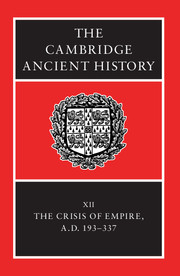Book contents
- Frontmatter
- PART I NARRATIVE
- PART II GOVERNMENT AND ADMINISTRATION
- PART III THE PROVINCES
- PART IV THE ECONOMY OF THE EMPIRE
- 11 Coinage and taxation: the state's point of view, a.d. 193–337
- 12 Coinage, society and economy
- PART V THE NON-ROMAN WORLD
- PART VI RELIGION, CULTURE AND SOCIETY
- Chronology
- Bibliography
- Index
- Topographical map of the Roman empire
- Map 2 The Roman empire in a.d. 211
- The Roman empire in a.d. 314
- The Rhine–Danube limes in the late second century
- References
12 - Coinage, society and economy
from PART IV - THE ECONOMY OF THE EMPIRE
Published online by Cambridge University Press: 28 March 2008
- Frontmatter
- PART I NARRATIVE
- PART II GOVERNMENT AND ADMINISTRATION
- PART III THE PROVINCES
- PART IV THE ECONOMY OF THE EMPIRE
- 11 Coinage and taxation: the state's point of view, a.d. 193–337
- 12 Coinage, society and economy
- PART V THE NON-ROMAN WORLD
- PART VI RELIGION, CULTURE AND SOCIETY
- Chronology
- Bibliography
- Index
- Topographical map of the Roman empire
- Map 2 The Roman empire in a.d. 211
- The Roman empire in a.d. 314
- The Rhine–Danube limes in the late second century
- References
Summary
From the last decades of the second century to the first decades of the fourth, the economy of the Roman world without doubt suffered the aftershocks of the violent tremors that shook the empire, most of them of a military and political nature. Also without doubt, the economy underwent fundamental changes in several respects, in part as a result of these shocks, in part as a result of more silent and subterranean forces, which reveal its proper logical mode of operation. But these changes, which remain to be defined, should not obscure the elements of continuity: it would be an exaggeration to talk about a massive upheaval.
Among the tremors, the following need to be mentioned so that they can be better classified:
the growing threats on the frontiers, starting in the north with the first invasions in the reign of Marcus Aurelius; then in the east, with the Sassanian conquest of Persia, and the subsequent series of invasions that sent raids ever further into Roman territory in the 260s and 270s in both east and west. We must consider that the enormous investments in defence were no longer sufficient to keep the frontiers secure;
wars of succession such as the empire had not experienced since 68/9, with their attendant pillaging, confiscations and executions, from Septimius Severus’ victory over Pescennius Niger and Clodius Albinus until the reunification of the empire by Constantine, by way of the defeats of Maxentius (312) and Licinius (324); at irregular intervals, the imperial power itself becomes the focus of a struggle for which the population of the empire paid dearly;
[...]
- Type
- Chapter
- Information
- The Cambridge Ancient History , pp. 393 - 439Publisher: Cambridge University PressPrint publication year: 2005
References
- 2
- Cited by

